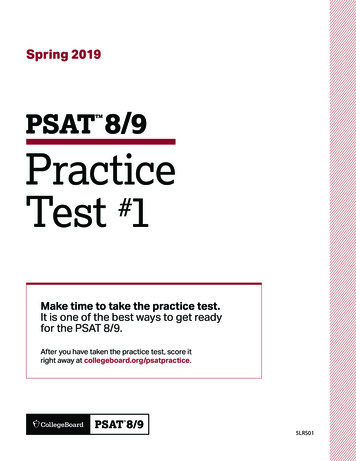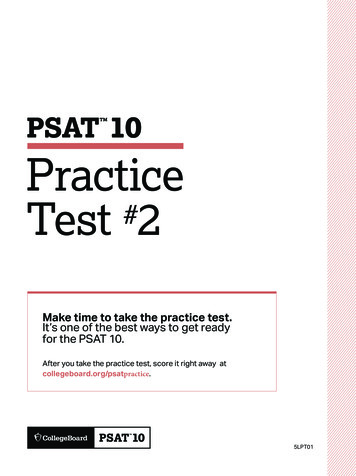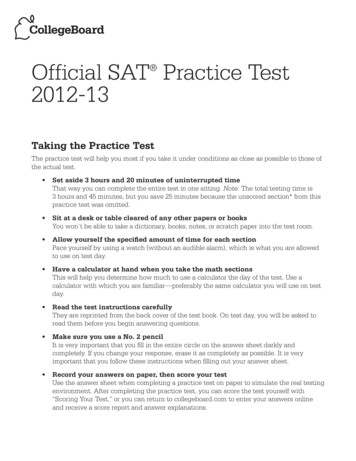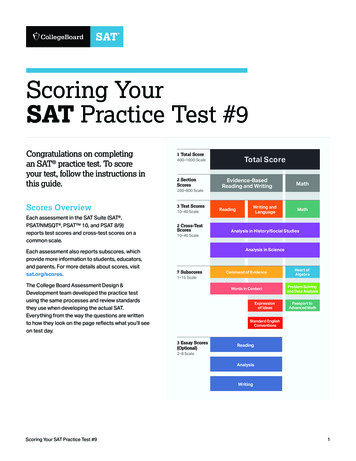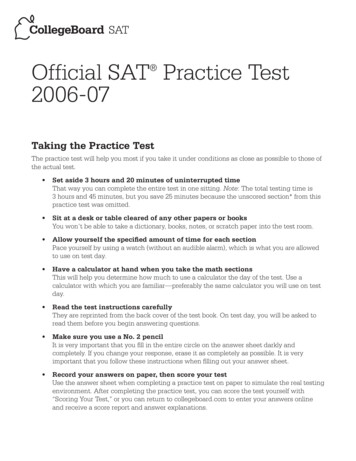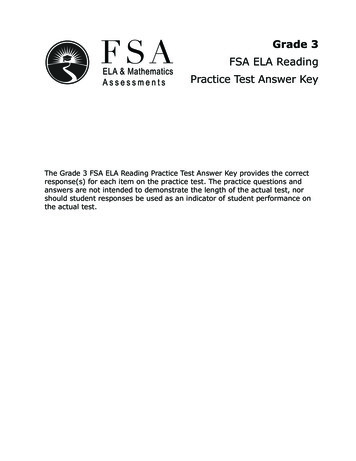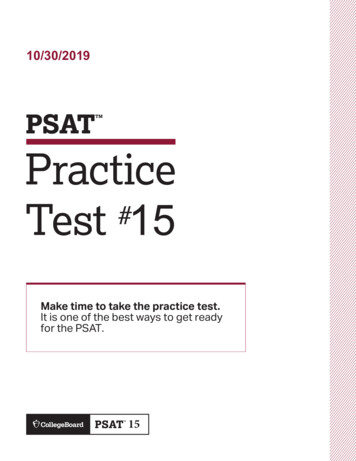
Transcription
10/30/2019PSAT Practice#Test 15Make time to take the practice test.It is one of the best ways to get readyfor the PSAT.15
11Question-and-Answer Service Student GuideReading Test60 MINUTES, 47 QUESTIONSTurn to Section 1 of your answer sheet to answer the questions in this section.Each passage or pair of passages below is followed by a number of questions. After readingeach passage or pair, choose the best answer to each question based on what is stated orimplied in the passage or passages and in any accompanying graphics (such as a table orgraph).This passage is from Yia Lee, “Broken Chords.” 2011 by Yia Lee.Line510152025Her place was run-down and small. It was latespring in Fresno, very hot and dry, and a window wasopen to catch a breeze. I liked her house because itsmelled similar to mine: sweet and starchy like rice.Over in the far corner, almost hidden underneath apile of clothes, was a piano. It caught my attentionlike a beacon. A piano doesn’t typically grace aHmong household. This one was an old upright.Kalia and I were friends, but this was the first time I’dbeen inside her house. I didn’t recall her saying sheplayed music.I wandered to it without trying to seem like I washeading directly there. But Kalia saw. She was a smallgirl, with skin the color of wet sand on the beach. Hershiny black hair was pulled back into its usualponytail. She smiled as I stopped in front of the piano.“Do you play, Katie?” she asked, getting up andsweeping away the clothes. She put them on thecouch, and then she lifted the lid to the keyboard. Thewhite and black keys winked at me.I sat down and plinked out a few notes. “It’s intune,” I said. Why had it been carelessly buried underall those clothes?She gestured for me to begin, so I started Mozart’sTwelve Variations on Twinkle, Twinkle, Little Star. Itwas one of my favorites. Deceptively simple, yet fullof energy and whim. My fingers were bouncingaround a rush of sixteenth notes, when a voicestartled me.Unauthorized copying or reuse of any part of this page is illegal.Questions 1-9 are based on the following passage.230354045505560“Aaron, shut up!” A booming male voice yelled inHmong.The music faltered and then I stopped. Kaliaappeared calm, but her black eyes were annoyed.“It’s not Aaron, she’s my friend!” she called backin English.“Oh, sorry, my bad.” A body attached itself to thevoice: a young man appeared in the doorway. Heglanced at us carelessly and went away.“That was my older brother. Ignore him, he’s anidiot.” Kalia tried to be lighthearted, and I smiled forher sake.“He doesn’t like piano?” I asked.She shrugged. “He’ll be leaving soon—he hardlyseems to live here anymore. Why don’t you finish thesong?”I finished the song, although the frolicking notesseemed false now. “Do you play?”Kalia shook her head.I thought, then asked, “Who’s Aaron?”“He’s Aaron.” Kalia motioned with her head and Irealized that there was another person at thedoorway. He must have been standing there as I wasplaying, for his face had an intent, pleased expression.His skinny frame was drowning in baggy clothes andthere was a gold stud in his left ear. Now that we werepaying attention to him he flashed us a small smile.His black eyes seemed vaguely familiar.“How was detention?” Kalia asked him drily.“Good,” he answered.“Maybe if you do your homework, you’d avoid it,”Kalia suggested.“Maybe,” said Aaron.CO NTI N U E
1707580859095Unauthorized copying or reuse of any part of this page is illegal.65“Perhaps if you showed up in class once in a while,that would help, too.”“Perhaps,” Aaron said, his voice too pleasant.It sounded like an old argument. Kalia lookedangry, and more tired than ever. I wasn’t sure what todo; my fingers hit a couple of keys accidentally.The sound of the piano shifted their attention tome. Aaron stepped into the room and approachedme. “That’s my piano,” he said.I got off the bench. “I’m sorry . . .”“Don’t be, it’s just that it hasn’t been played on fora long time,” he said, trailing a finger along the whitekeys. “It’s weird, coming here and hearing itagain . . .”“Well, then, why don’t you play something?” I said.The question just popped out of me and he hesitated.I sneaked a glance at Kalia; she was watching Aaronclosely. There were undercurrents that I wasn’t surehow to read. I was wondering if I’d somehow made amistake when he sat down abruptly on the bench andlet his fingers hover over the keys. Then he pressedthem down.He played Chopin, the etude nicknamed Ocean.His fingers flew as the music swept over the room. Hewas good. Not perfect, but he had good techniqueand he knew the music. I could see it in his eyes, theway they blazed a vivid crystal black.When Aaron stopped, there was a silence.I struggled to say something. Kalia beat me towords.“Aaron, this is my friend Katie Yang,” sheintroduced. “Katie, this is my little brother Aaron.”I said hello to him, he nodded and said,“Whatssup?”Then Kalia told him to go away and leave us alone;we were working on a project. But her tone was lessangry and had more humor. When he left I looked atthe piano. I could still hear the notes rolling in mymind.1Question-and-Answer Service Student Guide31Based on the passage, Katie’s interactions at Kalia’shouse suggest that Katie hasCO NTI N U E
1.CO NTI N U E4Unauthorized copying or reuse of any part of this page is illegal.1Question-and-Answer Service Student Guide
11Question-and-Answer Service Student GuidePassage 1 is adapted from Suchen Christine Lim, “SingaporeLiterature: A Moral Force to Be Reckoned With.” 2016 bySingapore Press Holdings Ltd. Co. Regn. No. 198402868E. Passage2 is adapted from Lauren Elkin, “National Literature: AnInternational Question.” 2008 by Guardian News and MediaLimited.Line510152025303540Passage 1A nation’s literature is the mirror through whichpeople see themselves. Children and adults need to seethemselves in their country’s fiction and poetry. LoisAnn Yamanaka, the Pushcart Prize-winning poet andauthor of the book Name Me Nobody, said: “. . . untilyou see yourself in literature, in the written word, youdon’t exist.” This is why every national schoolcurriculum includes the study of its nation’s literaryworks.Reading the literature of a country is like listeningto its heartbeat. One hears the hopes, fears and angst ofordinary folks like you and me. At the universal level,literature is the bridge built by Imagination to help uscross over into the interior landscape of those who aredifferent from us, and yet the same, and asextraordinary and odd as ourselves.The writer’s focus provides readers with insightsinto their society. To express the unexpressed, to saythe unsaid, to give voice to those with no voice— thishas always been one of literature’s many contributions.In literature, king or beggar, prime minister or dialectspeaking squatter, all are equal; all can take centrestage as the main character. No other school subjectfocuses on the individual or marginalised in the wayliterature does. This, in itself, is a moral force in aworld in which numbers count, and wealth, power andintellect dominate.Singapore literature has something to offer us, andthe world. It is neither monocultural nor monolingual.Comprising the poetry and fiction of four officiallanguages, Singapore literature writes across languageand culture. The congregation of English and Asianvoices is part of our national fabric and identity as apeople.The Singapore novelist writing in English acceptsthe challenge of recreating and rendering the variety ofAsian voices and languages into English. Our literaryfiction, poetry and plays offer the reader multipleperspectives and individual narratives that question,challenge and broaden our views of ourselves beyondthe national Singapore Story and the officiallysanctioned founding myth. In the long run, whilegeography and politics continue to shape our nation,our literature will reveal our collective soul.Unauthorized copying or reuse of any part of this page is illegal.Questions 10-19 are based on the following passages.5LinePassage 2“As a nation we have no literature,” the literarycritic Belinsky cries in despair in part one of TomStoppard’s play The Coast of Utopia, lamenting theinfluence of European writers on Russian writers, andstressing the importance of creating a national story oftheir own.50With storytelling comes a sense of identity. Butnational literatures evolve in stages, and the need for aliterature of one’s own changes according to thepolitical situation of the nation in question. A newnation, or a nation struggling to declare its55 independence, will be driven to create something thatis theirs, a literature that tells their national story. Butthe flux of modern history makes this a more or lessimpossible task.“The universal idea speaks through humanity itself,60 and differently through each nation in each stage of itshistory,” Belinsky says, later in the same speech. Theneed for a national literature changes according to themoment the nation is experiencing, and Stoppardcatches this exactly—on one hand the ardent yearning65 for one, and on the other, the contingency of theliterature on the historical moment.At the recent Festival America in Paris, the questionof a writer’s nationality and ethnic identity preoccupiedmost of the discussions. Chimamanda Ngozi Adichie,70 the Nigerian-born author of Half of a Yellow Sun,argued for Nigerian literature to be taught in Nigerianschools. “It’s a paradox,” she said. “People can beconsidered educated while knowing nothing about ourhistory. [They] read English books, not Nigerian75 books! What this means is we really don’t have a senseof our own history.” Such history, she said, could notbe written by outsiders. “The stories of Africa shouldbe written by Africans,” she declared.45CO NTI N U E
1.CO NTI N U E6Unauthorized copying or reuse of any part of this page is illegal.1Question-and-Answer Service Student Guide
1.CO NTI N U E7Unauthorized copying or reuse of any part of this page is illegal.1Question-and-Answer Service Student Guide
11Question-and-Answer Service Student Guide.Unauthorized copying or reuse of any part of this page is illegal.8Questions 20-28 are based on the following passage andsupplementary material.This passage is adapted from Emily Underwood, “Even in theWild, Mice Run on Wheels.” 2014 by American Association forthe Advancement of Science.Line51015202530354045In 2009, neurophysiologist Johanna Meijer set up anunusual experiment in her backyard. In an ivy-tangledcorner of her garden, she and her colleagues at LeidenUniversity in the Netherlands placed a rodent runningwheel inside an open cage and trained a motion-detectinginfrared camera on the scene. Then they put out a dish offood pellets and chocolate crumbs to attract animals to thewheel and waited.Wild house mice discovered the food in short order,then scampered into the wheel and started to run. Rats,shrews, and even frogs found their way to the wheel—more than 200,000 animals over 3 years. The creaturesseemed to relish the feeling of running without goinganywhere.The study “puts a nail in the coffin” of the debate overwhether mice and rats will run on wheels in a naturalsetting, says Ted Garland, an evolutionary physiologist atthe University of California, Riverside. More importantly,he says, the findings suggest that like (some) humans,mice and other animals may simply exercise because theylike to. Figuring out why certain strains of mice are moresedentary than others could help shed light on geneticdifferences between more active and sedentary people, headds.Even before Meijer got creative in her yard, researchersknew that captive mice are exercise maniacs. Inlaboratories and bedrooms, they frequently log more than5 km per night on stationary running wheels. Butscientists didn’t know why the animals did it.One thing was clear: they seem to enjoy it. Mice findexercise rewarding; just as they can be trained to press alever dozens of times to release a pellet of food, therodents will go to great lengths to unlock a running wheelwhen it has a brake on, and get back to spinning, Garlandsays. But is the drive to run normal, or is it an aberrant,obsessive behavior triggered by living in a shoebox-sizedcage?Meijer’s work seems to have answered that question.On average, the backyard mice she and colleaguesobserved ran in 1- to 2-minute stints, roughly the sameduration as that seen in lab mice. The team also set up asecond wheel in a nearby nature preserve of grassy dunesand attracted a similar crowd of enthusiasts. The animalskept running even when Meijer removed the food fromthe garden site, although they came in smaller numbers,she notes. Sometimes the rodents were so eager to runCO NTI N U E
11Question-and-Answer Service Student Guide556065The fact that the wild mice and other animals werebold enough to enter the cage and use the wheel is“very weird,” but perhaps not as surprising when oneconsiders that many domesticated animals also like torun on wheels, including dogs and chickens, saysJustin Rhodes, a neuroscientist at the University ofIllinois, Urbana-Champaign.Although the common house mice observed in thestudy tend to be more leery of novel structures thanother species—an evolutionary adaptation to thehuman penchant for building mousetraps—Garlandsuggests that the wheel may provide a more secureway for the animals to run than darting across anopen field. “There’s something attractive about beingable to get in a wheel and run unfettered.”Unauthorized copying or reuse of any part of this page is illegal.50that they couldn’t wait to take turns, she says: Atone point, a large mouse sent a smaller mouse flyingwhen it climbed on to the wheel and started runningin the opposite direction.9CO NTI N U E
1.CO NTI N U E10Unauthorized copying or reuse of any part of this page is illegal.1Question-and-Answer Service Student Guide
11Question-and-Answer Service Student GuideThis passage is adapted from Leonard Mlodinow, Subliminal: How YourUnconscious Mind Rules Your Behavior. 2012 by Leonard Mlodinow.Line51015202530354045Twentieth-century psychologist Frederic Bartlettbelieved that the distortions he had observed in people’srecall could be accounted for by assuming that their mindsfollowed certain unconscious mental scripts, which wereaimed at filling in gaps and making information consistentwith the way they thought the world to be. Wonderingwhether our social behavior might also be influenced bysome unconscious playbook, cognitive psychologistspostulated the idea that many of our daily actions proceedaccording to predetermined mental “scripts”—that theyare, in fact, mindless.In one test of that idea, an experimenter sat in a libraryand kept an eye on the copier. When someone approachedit, the experimenter rushed up and tried to cut in front,saying, “Excuse me, I have five pages. May I use the Xeroxmachine?” Unless the subject was making a great manymore than five copies, the experimenter has provided nojustification for the intrusion, so why yield? Apparently agood number of people felt that way: 40 percent of thesubjects gave the equivalent of that answer, and refused.The obvious way to increase the likelihood of compliance isto offer a valid and compelling reason why someone shouldlet you go first. And indeed, when the experimenter said,“Excuse me, I have five pages. May I use the Xeroxmachine, because I’m in a rush?” the rate of refusals fellradically, from 40 percent to just 6 percent. That makessense, but the researchers suspected that something elsemight be going on; maybe people weren’t consciouslyassessing the reason and deciding it was a worthy one.Maybe they were mindlessly—automatically—following amental script.That script might go something like this: Someone asksa small favor with zero justification: say no; someone asks asmall favor but offers a reason, any reason: say yes. The ideais easy to test. Just walk up to people approaching aphotocopier and to each of them say something like“Excuse me, I have five pages. May I use the Xeroxmachine, because xxx,” where “xxx” is a phrase that, thoughparading as the reason for the request, really provides nojustification at all. The researchers chose as “xxx” thephrase “because I have to make some copies,” which merelystates the obvious and does not offer a legitimate reason forbutting in. If the people making copies consciously weighedthis nonreason against their own needs, one would expectthem to refuse in the same proportion as in the case inwhich no reason was offeredUnauthorized copying or reuse of any part of this page is illegal.Questions 29-37 are based on the following passage andsupplementary material.11CO NTI N U E
155606570In their research report, those who conducted thisexperiment wrote that to unconsciously follow presetscripts “may indeed be the most common mode ofsocial interaction. While such mindlessness may attimes be troublesome, this degree of selective attention,of tuning the external world out, may be anachievement.” Indeed, here is the unconsciousperforming its usual duty, automating tasks so as tofree us to respond to other demands of theenvironment. In modern society, that is the essence ofmultitasking—the ability to focus on one task while,with the aid of automatic scripts, performing others.Unauthorized copying or reuse of any part of this page is illegal.50—about 40 percent. But if the very act of giving areason was important enough to trigger the “yes”aspect of the script, regardless of the fact that theexcuse itself had no validity, only about 6 percentshould refuse, as occurred in the case in which thereason provided—“I’m in a rush”—was compelling.And that’s exactly what the researchers found. Whenthe experimenter said, “Excuse me, I have five pages.May I use the Xerox machine, because I have to makesome copies?” only 7 percent refused, virtually thesame number as when a valid and compelling reasonwas given. The lame reason swayed as many people asthe legitimate one.1Question-and-Answer Service Student Guide12CO NTI N U E
11Question-and-Answer Service Student Guide.Unauthorized copying or reuse of any part of this page is illegal.13Questions 38-47 are based on the following passage.This passage is adapted from Elizabeth Pennisi, “How DoMicrobes Shape Animal Development?” 2013 by AmericanAssociation for the Advancement of Science.Line510152025303540Animals and plants have always shared space withbacteria, fungi, viruses, and other microbes, coevolvingthrough the millennia. In the mid-1800s, however,scientists came to view microbes primarily as enemiesand fought hard with antibiotics, vaccines, and goodhygiene to get the best of them. But the microscopicworld is so intertwined with macroscopic life that theidea that each multicellular animal exists as a separateindividual defined by its genome is falling by thewayside. There is a growing realization that microbesand their genes are partners in each animal’s journeyfrom egg through adulthood. “What we understand tobe the ‘individual’ develops as a consortium of animalcells and microbes,” says Scott Gilbert, a developmentalbiologist from Swarthmore College in Pennsylvania.“Microbes came before us, so all development thattakes place in all organisms has basically been takingplace in the presence of the microbiota,” adds SvenPettersson of the Karolinska Institute in Stockholm.The evidence for coevolution in developmentalprocesses is coming from far corners of the animalkingdom. Whereas marine biologists once thought thatthe drifting larvae of coral, snails, and other oceangoinginvertebrates randomly settled down to become adults,they now know that many respond to cues frombacterial biofilms (colonies of microorganisms thatadhere to a surface) to pick their new homes. And whilemany animals develop in wombs or eggs apparently freeof microbes, they may still rely on microbes to set inmotion or complete certain aspects of postnataldevelopment. Mammals acquire microbial partners afterbirth and seem to have evolved strategies to encouragethe right species to settle in specific places. Human milk,for example, contains complex sugars that infantscannot digest but which promote the growth ofintestinal bifidobacteria.But what do these microbial partners do? Germfreemice have finally allowed researchers to beginaddressing this question. These are mice that lack theusual complement of gut bacteria because they are bredand raised in sterile environments and eat sterilizedfood. Studies of such mice make an increasingly strongcaseCO NTI N U E
150556065707580that bifidobacteria and other gut bacteria guide thepostnatal maturation of the intestinal and immunesystems, and even parts of the brain, in mammals. Themicrobes turn on mammalian genes important forcellular differentiation (the process by which lessspecialized cells become more specialized) and producemetabolic products that may also affect development.Gut-associated lymphoid tissue and the capillary beds ofthe villi of the intestine fail to adequately develop ingermfree mice, for example.The evidence for a role for symbionts (the smallerparticipant in a relationship between two differentorganisms) in the postnatal developing brain is morepreliminary but nonetheless intriguing. More and moreconnections are being found between the gut microbiotaand behavior. In 2011, Pettersson and his colleaguestested anxiety levels and locomotor activity in germfreemice and found that the rodents are hyperactive and havea decreased level of anxiety compared with mice with ahealthy microbiota. There were also differences in theactivity of genes associated with motor activity andanxiety. There seems to be a window of activity for themicrobiota to influence behavior patterns: Colonizinggermfree mice with normal mouse microbes negatedthese differences in young, but not older, mice, theyreported.Some work suggests that gut microbes influencebehavior through the vagus nerve, which connects thebrain with the digestive system, but Pettersson and otherssuspect a role for blood-borne bacterial products as well.These products, which make up 10% or more of themetabolites in blood, may extend the reach of the gutmicrobiota throughout the body.That realization may mean that prenatal developmentin mammals isn’t as free from microbial influence aseveryone has thought. In mammals, the developing fetusis virtually bacteria-free; hence, researchers have focusedon finding a role for bacteria in development after birth.Yet blood-borne metabolites from a mother’s gut germscould exert an effect on a growing fetus. “That was one ofthe assumptions, that pregnancy did not involvemicrobes,” Gilbert says. “But it probably does.”Unauthorized copying or reuse of any part of this page is illegal.451Question-and-Answer Service Student Guide14CO NTI N U E
1.CO NTI N U E15Unauthorized copying or reuse of any part of this page is illegal.1Question-and-Answer Service Student Guide
22Question-and-Answer Service Student GuideWriting and Language Test35 M I NU TES, 4 4 QUESTIONSTurn to Section 2 of your answer sheet to answer the questions in this section.Each passage below is accompanied by a number of questions. For some questions, youwill consider how the passage might be revised to improve the expression of ideas. Forother questions, you will consider how the passage might be edited to correct errors insentence structure, usage, or punctuation. A passage or a question may be accompanied byone or more graphics (such as a table or graph) that you will consider as you make revisingand editing decisions.Some questions will direct you to an underlined portion of a passage. Other questions willdirect you to a location in a passage or ask you to think about the passage as a whole.After reading each passage, choose the answer to each question that most effectivelyimproves the quality of writing in the passage or that makes the passage conform to theconventions of standard written English. Many questions include a “NO CHANGE” option.Choose that option if you think the best choice is to leave the relevant portion of thepassage as it is.Crowdfunding for MusiciansFor musicians, signing a contract with a recordcompany to produce an album is a dream that only alucky few achieve. But musicians don’t have to rely onthis traditional model for getting their music out to theworld anymore. They would do well to consider analternate method called crowdfunding. Crowdfunding isthe practice of soliciting money 1 from where thepublic—typically through Internet platforms such asKickstarter and PledgeMusic—to fund personal projects.Musicians can create fund-raising 2campaigns. Acampaign can cover expenses such as renting a studio,.Questions 1-11 are based on the following passage.1A. NO CHANGEB. fromC. byD. out of2Which choice most effectively combines thesentences at the underlined portion?A. campaigns while coveringB. campaigns, and they do so to coverC. campaigns to coverD. campaigns, and then they covermaking an16CO NTI N U E
2campaign reaches its financial goal, pledgers receiverewards based on how much they initially contributed.3 Even before Kickstarter and PledgeMusic, bandswere using the Internet business model to fund theirmusic. One of these early success stories was the Britishband Marillion. In 1996 the band’s members set up theirown website to help finance their upcoming NorthAmerican tour, and they 4 manage to raise 60,000from their fans. A few years later, facing conflict withtheir record label and management team, they turnedagain to the public, 5 asking fans to preorder their nextalbum—essentially as a way of funding its production.Unauthorized copying or reuse of any part of t
Oct 07, 2020 · PSAT Practice Test # 15 Make time to take the practice test. It is one of the best ways to get ready for the PSAT. 15. Questionand-Answer ervice tuent uie. Reading Test. 60 MINUTES,
